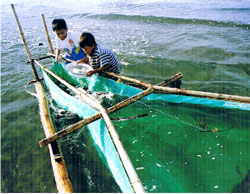Tigbauan celebrates Saludan Festival

Tigbauan, is one of Iloilo's treasure trove, packed with "gems" from more than a millennium of historical significance. With one foot in the past, and the other in the present, Tigbauan allows every visitor a glimpse of its heady blend of architectural masterpieces and natural wonder, the town's 134 years of history are on display when you look.
Formerly known as "Katigbawan" (field of reeds), Tigbauan is a fourth-class town 22.5 kilometers from Iloilo City. Its geographical position make it part of the First District clusters of towns in the province. Occupying the southern part of the province, it is bordered in the north by Leon, San Miguel in the northwest, in the east by Oton, the Iloilo Strait in the south and west by Guimbal.
Its total area is 6,062 hectares. Flat terrain account for 75 percent of that figure, with 94% devoted to agriculture.
The town delights its St. John of Sahagun Parish. Constructed using forced labor under Fray Florencio Martin in 1867, its beautiful baroque facade in rococo finish, allow visitors a glimpse of the community's intense spirituality. The church's remarkable architecture with its façade and tower, survived the ravages of the Second World War and the great earthquake in 1948. Presently, the mystical beauty of its altar depicts heaven and Dante's Inferno; the church walls with the Way of the cross, all done in intricate mosaic of colored stones is a sight not to be missed. On its churchyard remained a marker of what used to be the site of the first Jesuit boarding school for boys in the Philippines established in 1592 and renowned that time for their liturgical music during church services.
Relatively unknown to most Ilonggos, the beach in Barangay Parara was the landing site of America's 40th Infantry Division to liberate Panay and Romblon during the Second World War in March 18, 1945. The same area became the landing site in the 13th century of the descendants of the Bornean Datus.
Although relatively small, Tigbauan is one of Iloilo's leading towns in fish production. Its municipal waters, abundant with fish are oftentimes producing more than what residents can consume. Three of from its ten coastal barangays namely, Barroc, Atabayan and Bangingin are engaged in bagoong production and are shipped and sold in Manila, Cebu and Mindanao areas. Dried small shrimps or hipon are exported as far as Japan and other ASEAN regions. The presence of SEAFDEC (South East Asian Fishery Development Center) in Barangay Buyu-an, complete with amenities and facilities, caters information and technical service on bangus and prawn culture.
Although Tigbauan is a fourth-class town, those who want in on the action head straight for the adjacent barangays a few meters away from the town's poblacion. Coco-Grove, Sunflower and Sol Y Mar beach resorts embrace the playground of the tanned and in high spirits.
During this time, the community celebrates their great merit and prosperity through Saludan Festival. Coined from a Hiligaynon term salud---the crude method of catching fingerlings through nets, the festivity is a fitting tribute to a livelihood that provides fisher folks their source of living. With the theme Tigbauanon: Nagaulikid sa kahapon, nagabuylog sa Kauswagan sa karon kag Nagahandum sang Maayo nga Palaabuton, the municipality of Tigbauan together with their supportive municipal mayor, Myrna M. Torres, is delighted to invite everyone to witness this year's festivity from October 22-28, 2006, with their festival highlight, the tribe competition on October 27, 2006 at 8:00 a.m. at the town plaza Hoping to attract visitors from neighboring towns and guests from around the region, Saludan Festival coincides with this year's Western Visayas Tourism Assembly in SM City Activity Center on October 23-29, 2006.
Bombette G. Marin
